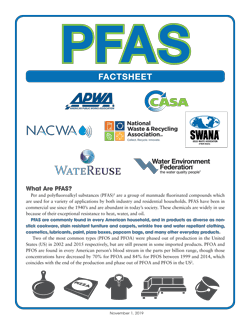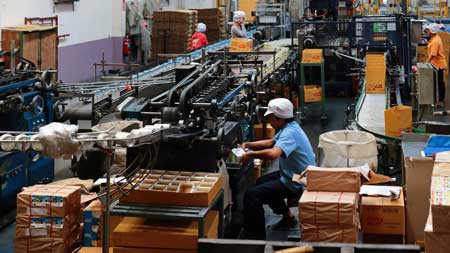Your Source for Information on Per- and Polyfluoroalkyl Substances (PFAS)
What are PFAS?
Per and polyfluoroalkyl substances (PFAS) are a group of manmade fluorinated compounds that are used for a variety of products in industry and residential households. PFAS have been in use since the 1940s and are commonplace in our environment today. These chemicals were used because they are exceptionally resistant to heat, water, and oil.

In 2024, the US Environmental Protection Agency set enforceable Maximum Contaminant Levels (MCL) of 4.0 parts-per-trillion (PPT) for two of the most common types, PFOS and PFOA. They also set a Maximum Contaminant Level Goal (MCLG—a non-enforceable health-based goal) for these two chemicals at zero. For other PFAS chemicals (PFNA, PFHxS, PFBS, and “GenX Chemicals”), the EPA is setting their MCLGs and MCLs at 19 parts parts-per-trillion. EPA is also setting a limit for any mixture of two or more PFAS compounds.
PFAS in Our Environment
PFAS compounds are now found everywhere in our environment. Major sources of PFAS are:
Household Products
Production Facilities
Food
Where We Live
Household dust containing PFAS has been found to be 10,000–50,000 PPT over the EPA threshold for drinking water. However, it is unclear whether PFAS enters the human body by inhaling contaminated dust. For now, the main route of exposure appears to be from eating and drinking contaminated foods (or water-to-crop transfer). The Environmental Research & Education Foundation estimates that the average person consumes 146–600 nanograms of PFAS per day through food consumption and dust intake.
PFAS Concentrations and Exposure Factsheet
SWANA and NWRA developed a factsheet to help people understand PFAS in landfill leachate relative o common exposure sources and pathways.
Reducing PFAS in the Environment
The most significant and effective action that can be taken to reduce PFAS in the environment is to remove these chemicals of concern from the stream of commerce and pursue cleanup and remediation at highly contaminated sites. Source reduction and pollution prevention can serve as the most efficient means of addressing the persistent background presence of PFAS and effectively limit exposure to PFAS going forward.
PFAS Producers Are Not the Same as PFAS Receivers
Receivers are facilities who receive PFAS as a result of their processes. Recievers convey and/or manage traces of PFAS coming into their systems daily.
- Drinking water treatment systems
- Wastewater treatment facilities
- Municipal solid waste landfills
Producers are those companies who utilize PFAS in their processes. To stop the true sources of PFAS, it is imperative to:
- Discontinue production (both domestic and foreign) at manufacturing facilities
- Find safer alternatives for heavy use areas such as firefighting training sites
Landfills and Waste Combustors as Receivers of PFAS
It is vital for EPA to recognize that municipal solid waste landfills and waste combustors are not producers or users of PFAS. They do not utilize or profit from PFAS chemicals. Rather, they are receivers of these chemicals used by manufacturers and everyday consumers, and merely convey and/or manage the small quantities of PFAS coming into their systems. Receivers of PFAS residuals and wastes should not be subject to nor assume the same level of responsibility as PFAS manufacturers. As long as PFAS are elements of products used in our everyday lives, and background levels persist, these chemicals will continue to be found in receiver streams.
Further Reading
- Brown, et al., “Assessing Human Health Risks from Per- and Polyfluoroalkyl Substance (PFAS)-Impacted Vegetable Consumption: A Tiered Modeling Approach”, Environ. Sci. Technol., 2020.
- Domingo and Nadal, “Per- and Polyfluoroalkyl Substances (PFASs) in Food and Human Dietary Intake: A Review of the Recent Scientific Literature”, J. Agric. Food Chem., 2017.
- Fraser, et al., “Polyfluorinated compounds in dust from homes, offices, and vehicles as predictors of concentrations in office workers’ serum”, Environ. Int., 2013.
- Hall, et al., “Per- and Polyfluoroalkyl Substances in Dust Collected from Residential Homes and Fire Stations in North America”, Environ. Sci. Technol.
- Karásková, et al., “Perfluorinated alkyl substances (PFASs) in household dust in Central Europe and North America”, Environ. Int., 2016.
- Staley, Brian, Ph.D., P.E., “Per- and Polyfluoroalkyl Substances (PFAS) in Solid Waste”, Environmental Research & Education Foundation/US Composting Council, 2019.
- US EPA, “Drinking Water Health Advisories for PFOA and PFOS”, 2016
Advertisement
Survey on leachate at public landfills
Drs. Stephanie Bolyard (Florida State University) and Nick Chen (University of Central Florida) are conducting a short survey on the generation and treatment of leachate at public landfills in the Eastern US and Pacific Northwest in 2021. More information about the study is on MySWANA.
Reps for eastern US & Pacific Northwest public landfills can fill out the survey hereSpecial Thanks
A special thank you to the Landfill Technical Division Landfill Leachate and Liquids Committee for providing up-to-date scientific and technical data about PFAS in solid waste.
Join Team/ContributePFAS Factsheet

SWANA, APWA, CASA, NACWA, NWRA, WaterReuse, and WEF collaborated to create a PFAS factsheet in 2019.
Download the PFAS Factsheet




















